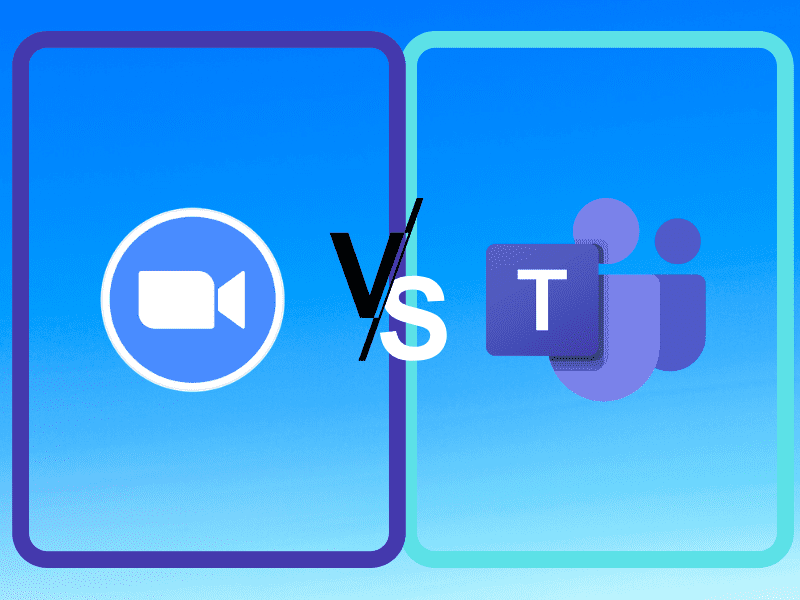Zoom and MS Teams are both powerful video conferencing tools. So deciding which one to use for your business can be a BIG decision. You don’t want to be switching it up every day of the week. Meetings are already hectic enough as they are, the last thing people need is multiple platforms to keep track of.
@tldv.io Makes perfect sense. #meeting #comedy #corporate #meetings #9to5 #firstday
♬ original sound - tldv.io - AI Meeting Recorder
But which video conferencing platform is better for your business? Zoom or Microsoft Teams?
In this comparative guide, we’ll scrutinize two heavyweights of the online meeting game, Zoom and Microsoft Teams. We’ll take a look at pricing, usability, unique features, compatibility with extensions or add-ons, and much, much more. All in all, it will help you make a very personal decision: which platform is best for your business.
High-Level Overview
Let’s have a quick look at the two side by side.
FEATURE | MS TEAMS | ZOOM |
FREE PLAN | For home use, unlimited calls up to 60 mins each. Up to 100 attendees. | Unlimited calls up to 40 mins each. Up to 100 attendees |
PRICE | $4-12.50 per month | $9.99- $17 per month |
MAX NUMBER OF PARTICIPANTS | 1,000 (or 19,000 in view only) | 1,000 |
RECORD MEETINGS? | On paid plans | On all plans |
Available for scheduled meetings with paid plans | Available on Business and Enterprise plans | |
INTEGRATIONS | 250+ | 1,000+ |
EASE OF USE | Mostly Easy | Easy |
FEATURES | DRAW | DRAW |
VIDEO & AUDIO QUALITY | Excellent | Excellent |
TARGET AUDIENCE | Businesses and enterprises | Medium-sized businesses, educational institutions, and individuals |
SECURITY | Excellent | Good |
COMPATIBLE WITH tl;dv | Yes | Yes |
TOTAL | 5 | 3 |

You might think this little overview answers your question for you. I can assure you it doesn’t. This is just a bird’s eye view so you can have a general idea of what MS Teams and Zoom provide.
In reality, the video calling platform you choose for your business will depend on a number of factors:
- How large is your business?
- How many employees are there, and will they all need to join calls together?
- Which apps do you already use?
- Do you need lots of integrations with your other work apps?
Other questions like these will dictate whether you choose Zoom or MS Teams. Where Zoom has waaaay more integrations, MS Teams has a cheaper plan scheme. There are benefits and drawbacks to both. It’s down to you to figure out how they’ll affect your business and which one will suit you best.
With the overview out of the way, let’s get down to the nitty gritty details!

Microsoft Teams vs Zoom: Free Plans
Both Microsoft Teams and Zoom have free plans so you can get started with either one of them today. However it should be noted that MS Teams caters their free plan mostly to individuals calling their friends and family. There are no free plans for business – though there aren’t exactly checks so long as you stick to the limits of the plan.
Zoom, on the other hand, makes no suggestion about how you use the free plan. Like MS Teams, it allows for up to 100 attendees on the free plan, but the meetings are awkwardly capped at 40 minutes (as opposed to MS Teams’ 60 minutes).
FREE PLANS | MS TEAMS | ZOOM |
MINUTE CAP | 60 minutes per call. | 40 minutes per call. |
NUMBER OF PARTICIPANTS | 100 | 100 |
CLOUD STORAGE | 5GB | N/A |
RECORD MEETINGS? | N/A | Yes |
MEETING TRANSCRIPTS? | N/A | N/A |
FEATURES | Collaborative planning with tasks and polling, data encryption | Team chat, mail and calendar, basic clips, notes, whiteboard |
All in all, Zoom’s free plan offers more features and video recording, whereas MS Teams offers longer calls and cloud storage. Both are good free plans as you can invite a lot of participants without spending a single cent. We know it’s frowned upon, but if you really wanted to, you could always end the call and start a new one straight after. It’s annoying, particularly if you have a larger number of participants, but it’s doable.
You’ll have to decide on the right balance for your business, but more likely you’ll be looking at one of the paid plans…
Microsoft Teams vs Zoom: Paid Plans
Both Zoom and MS Teams have a number of paid plans to choose from. MS Teams has divided theirs into Business and Home, so for this comparison we’re going to focus strictly on their Business plans.

The cheapest plan for Zoom starts at $149.90 per year ($12.49 per month) while MS Teams’ first paid option is more than three times cheaper: $4 per month (not including tax). Both platforms allow for meetings up to 30 hours, and MS Teams ups the number of participants to 300. Zoom lags behind with meeting participants still stuck at 100. They also include 5gb cloud storage – something MS Teams offers for free.
The best new feature for Zoom at this tier is their AI companion. However, it’s worth noting that Zoom’s cheapest paid plan is the same price as MS Teams’ most expensive one.
PAID PLANS | MS TEAMS | ZOOM |
LOWEST TIER PRICE | $4 per month | $12.50 per month |
HIGHEST TIER PRICE | $12.50 per month | $22.49 per month. Enterprise requires you to contact sales. |
NUMBER OF PARTICIPANTS | 300 | 100-300. Enterprise: 1,000! |
CLOUD STORAGE | 5GB free. | 5GB in the lowest tier. 10GB in the highest tier. |
RECORDS MEETINGS? | Yes | Yes |
MEETING TRANSCRIPTS? | Yes | Yes |
FEATURES | Collaborative annotations, whiteboard, live captions. At mid-high plans, you unlock all Microsoft apps and services. | Clips Plus, AI companion, Notes, and more. |
If you’re comparing the plans alone, it looks as though MS Teams has the upper hand. Not only is it a lot cheaper, but you also unlock the entire Microsoft suite, including Word, Outlook, OneDrive, PowerPoint, Excel, and more.

It also has much higher cloud storage capacity (as it works with all the other apps you unlock too). Zoom is not without its perks, however. It comes with an AI companion, something that MS Teams is yet to incorporate. Zoom also has up to 1,000 participants, although that only works in the Enterprise plan which doesn’t have a price listed.
Based on the plans alone, MS Teams is the clear winner, but is there a reason Zoom costs more? Let’s take a look at the video and audio quality comparison, two of the most important facets of video calls.
Zoom vs Microsoft Teams: Audio and Video Quality
While Zoom holds up well in high-traffic situations, giving 720p video quality for free, and 1080p in the paid plans,it’s MS Teams that shines again. They have an AI-optimized 1080p video quality for basic users and above. In addition to that, MS Teams is widely recognized as being stable and having top quality video and audio, even during larger calls.
Microsoft suggests a minimum connection speed of 2mbps to maintain this level of quality, while Zoom requires 3mbps for the same quality.
As for audio settings, users most likely won’t notice a difference between the two. Any real difference will be more to do with the user’s hardware and internet connection than either of the softwares.
In the end though, there’s not too much difference between them. It’ll likely come down to the user’s personal preference and the overall ease of use.
Zoom vs Microsoft Teams: Usability
While MS Teams seems to be triumphing so far, there’s no question that Zoom is the easier tool to use. Not that MS Teams is difficult – not by a long stretch – but Zoom is as simple as you could possibly imagine. Growing in popularity during the pandemic, almost everyone has used Zoom at some point. It was so ubiquitous during lockdowns that it became synonymous with video calling.

For this reason, Zoom is the winner for usability. Nobody on your team will have a problem using it for video calls. In most cases, it’s as simple as following a link. The layout and display on the actual call screen is intuitive and easy to learn too.
MS Teams, by comparison, has a small learning curve. It’s not anything to be afraid of, but it’s not quite as straightforward and simple as Zoom.
Zoom vs Microsoft Teams: Integrations
This is where things get interesting. MS Teams obviously has top tier integrations with its entire Microsoft suite. It’s easy to integrate it with your other Microsoft products, and you can even integrate it with around 250 other work and productivity apps.
However, because it’s a Microsoft product, there are less options than something like Zoom, which is free to integrate with all sorts of different apps. Think of MS Teams like an iPhone or MAC. They have their own special cables and can’t be used with Android things. MS Teams is a little similar. It feels a bit boxed in.
Zoom, on the other hand, integrates with over 1,000 apps, including Google Drive, Dropbox, Slack and more.
This makes it a bit more of a decisive factor. If your entire team already uses Microsoft products, like OneDrive, Excel, PowerPoint and the like, then MS Teams is a no-brainer. If, however, you’re using Google Drive or Dropbox instead of OneDrive, Zoom might be a better choice. This is because you’d have to change up your entire system and potentially limit yourself with MS Teams.
Do They Integrate With tl;dv?
You’ll be pleased to hear that both MS Teams and Zoom integrate with tl;dv. That means if you want to record your meetings with style (and substance) then you won’t need to use their built-in recorders (which are both costly and extremely basic). Instead, you can use the tl;dv extension and record, transcribe with top-of-the-range speaker recognition, make notes, timestamp the best bits, get AI summaries of everything that was said, make clips, make highlight reels, and much, much more.
Starting with unlimited calls and transcripts for FREE, tl;dv’s bot can join any call you have on MS Teams or Zoom and even make notes on your behalf so you can remain focused on the conversation. It’s great if you want to make the most out of your video call recordings.
Microsoft Teams vs Zoom: Features
Another biggie to consider: which features do you want for your business? MS Teams, for example, is a blockbuster platform that extends beyond just mere video conferencing. It provides an array of advanced collaborative features like simultaneous document editing and task management through its other Microsoft products.
Zoom has more of a laser focus on video calls. It’s hyper specialized but this isn’t necessarily a good thing. After all, most of Zoom’s features are also available to MS Teams users. While Zoom focuses on the video call side of things, MS Teams is just one area of an entire workplace suite.
Zoom does feature an AI companion in its paid plans, which is something that MS Teams hasn’t introduced as of yet. However, besides that their features are fairly similar. Again, Zoom’s user interface makes it easier to use for newcomers, but both tools get the same job done effectively.
As mentioned earlier, neither tool particularly excels at meeting recording or transcribing. Those features are offered more as an afterthought. If you want a highly specialized video recorder with timestamps, AI notes and summaries, and automatic speaker recognition, you can download tl;dv and partner it with your video conferencing platform of choice. It even works with Google Meet.
Zoom vs Microsoft Teams: Security
If you’d have asked which video conferencing platform was better security-wise three years ago, MS Teams would’ve been the standout winner. Zoom had a few privacy scares during the early days of the pandemic as it wasn’t prepared for such a high increase in users. Some people could exploit Zoom to join other people’s meetings without an invite. It became known as Zoombombing.
Since then, Zoom focused heavily on improving security. Now it offers the following:
- Meeting password protection
- End-to-end encryption for meetings
- Host has the power to control participant access and screen-sharing abilities
MS Teams, on the other hand, has always been a secure platform. Sure, there are still scares from time to time, but MS Teams has a robust set-up. Some of the security features it has include:
- Multi-factor authentication
- Data encryption
- Compliance with industry-standard security certifications
MS Teams also gives users access to fine-tune controls over user permissions, guest access, and data retention policies.
All in all, MS Teams is probably the more reliable platform, largely because Microsoft has been an industry giant for multiple decades. In that respect, they are more trustworthy. However, Zoom’s security is nothing to complain about.
So Which Is Better?

So it boils down to the final question: which is better, MS Teams or Zoom?
The answer is the same it’s always been: it depends.
It depends on your business needs, on the apps that your team is currently familiar with, on the budget you have to spend, and on whether or not other Microsoft products are something you’re interested in.
It must be said that if your team also uses Word, Excel, PowerPoint, OneDrive, or any other Microsoft product, then MS Teams is almost definitely the best choice for you. However, if you don’t use any of them, that doesn’t mean you should automatically pick Zoom. It just means that you’re on a more level playing field.
There are many integrations that Zoom has which MS Teams does not have. This might be something you should dig a little deeper into. You don’t want to sign up to MS Teams only to find out that it doesn’t integrate with Google Drive. For the record, it is possible to use Google Drive with MS Teams but it can be a bit more fiddly than Zoom.
Hopefully this article has outlined the pros and cons of Microsoft Teams vs Zoom enough for you to come to your own conclusion. Whichever platform you decide to use, remember to download tl;dv to get the most out of your video call recordings and transcripts. It’s particularly useful for user researchers, hiring teams, customer support teams, and sales teams.














